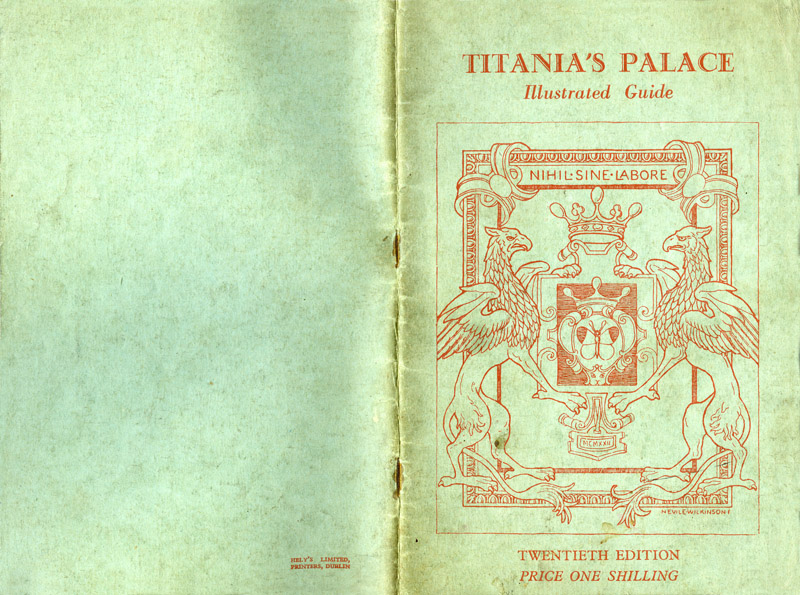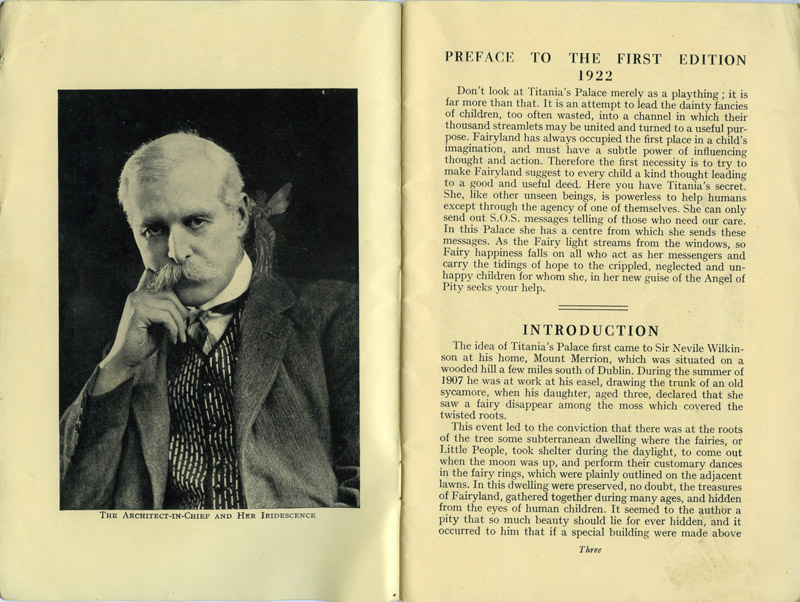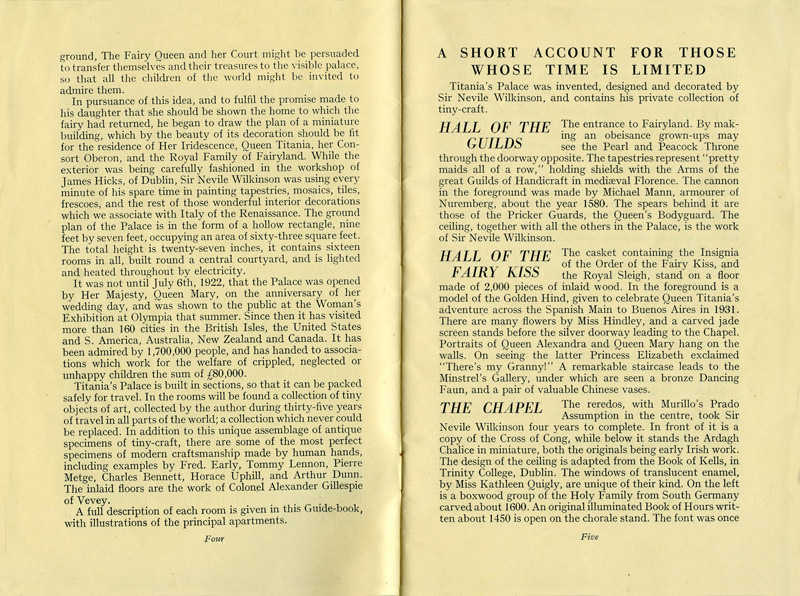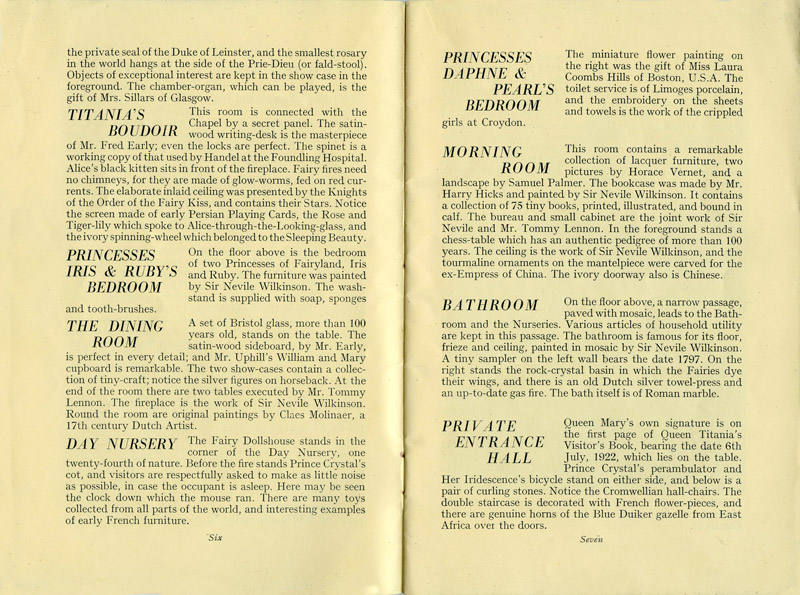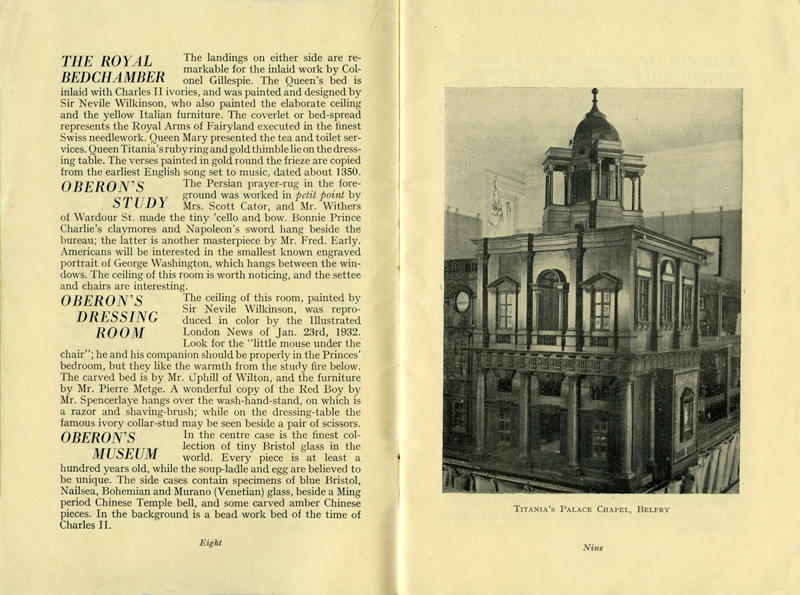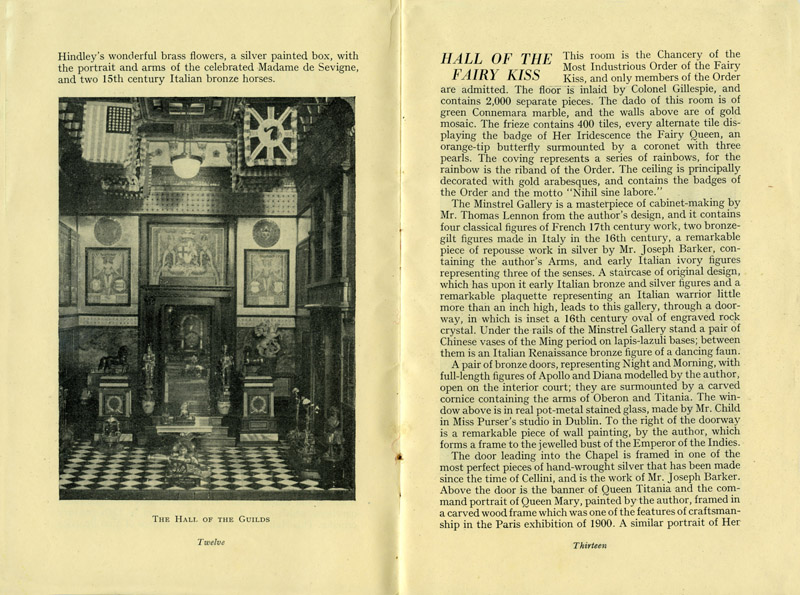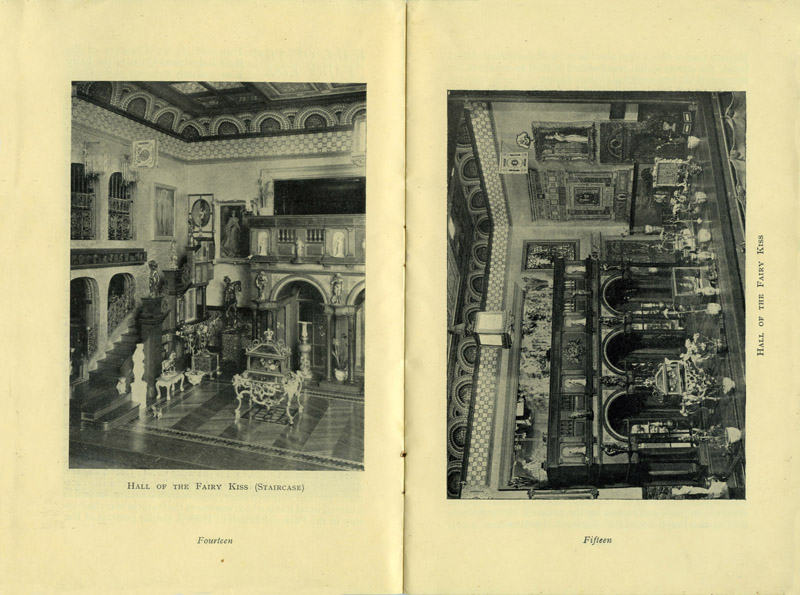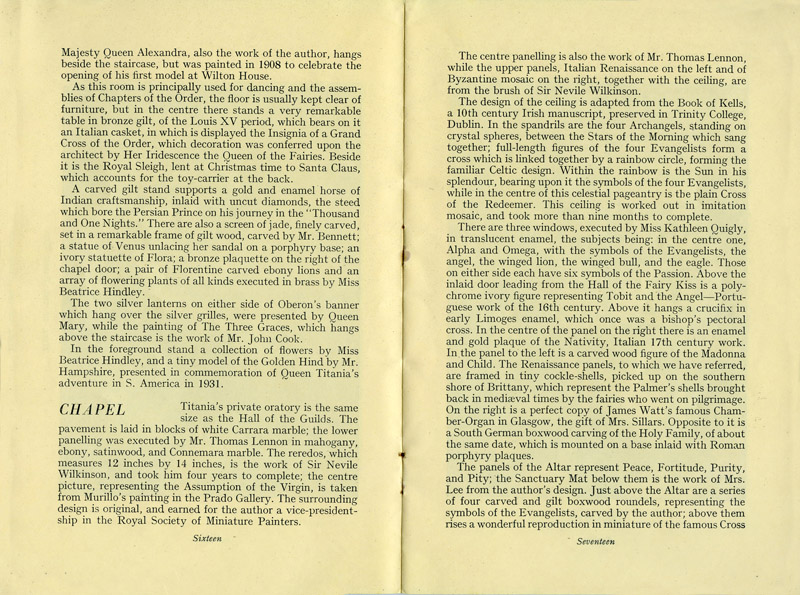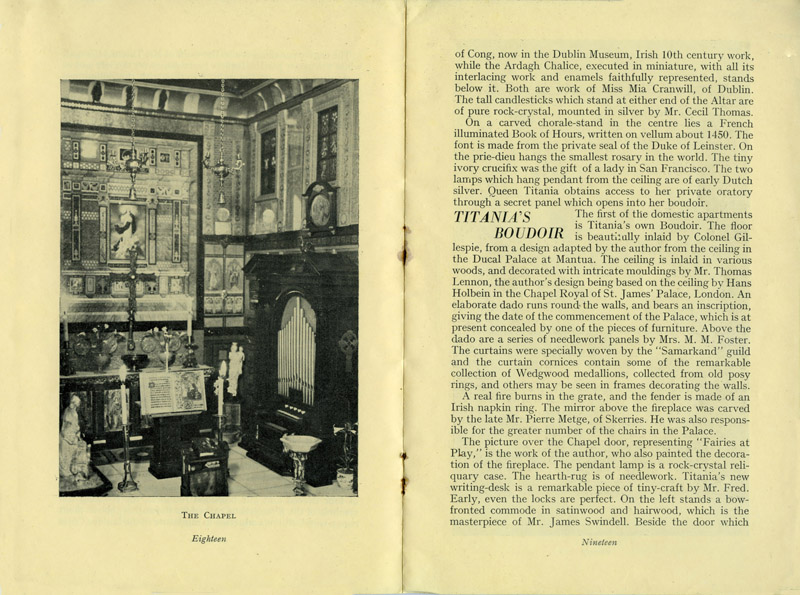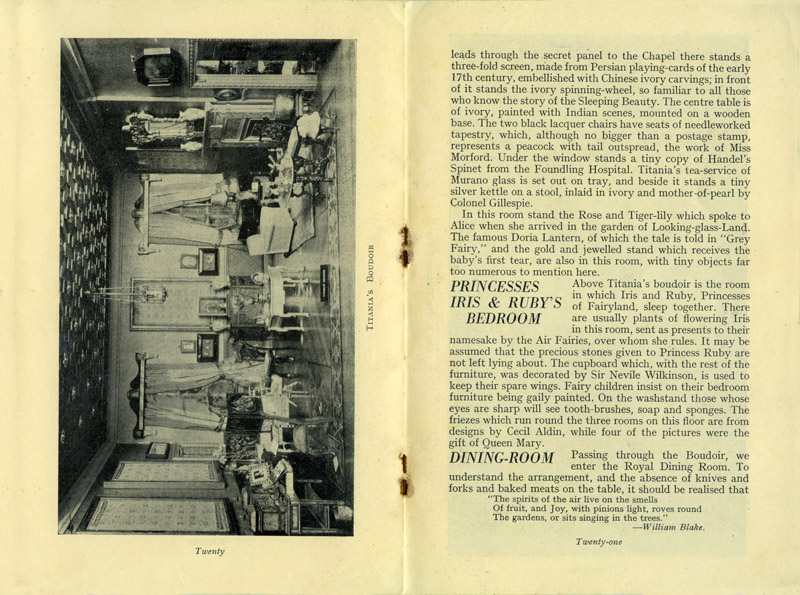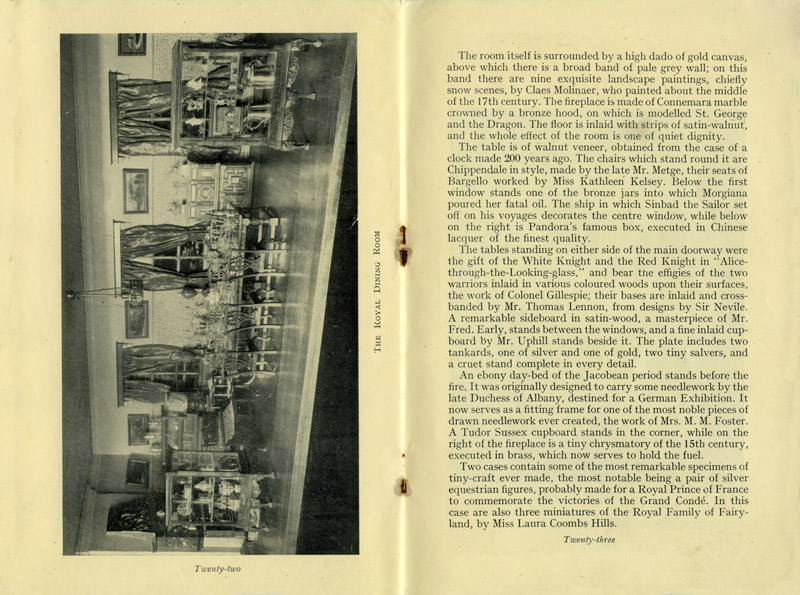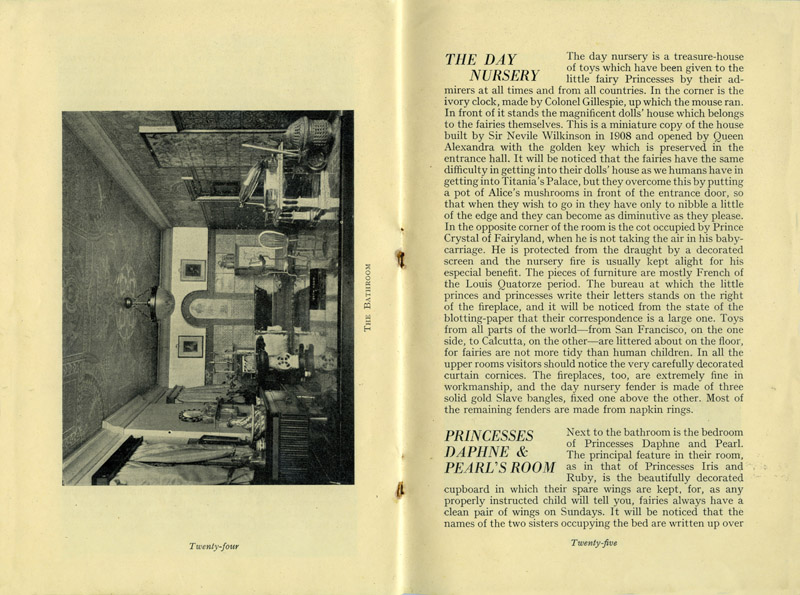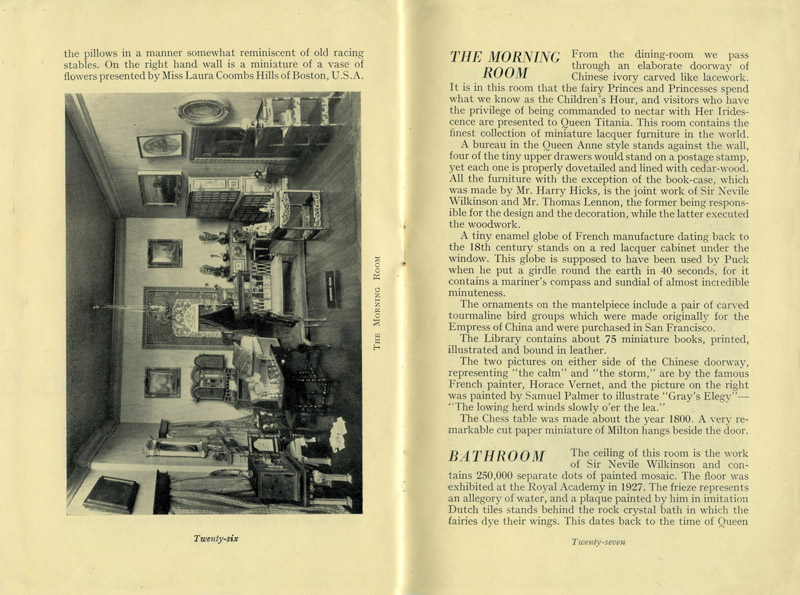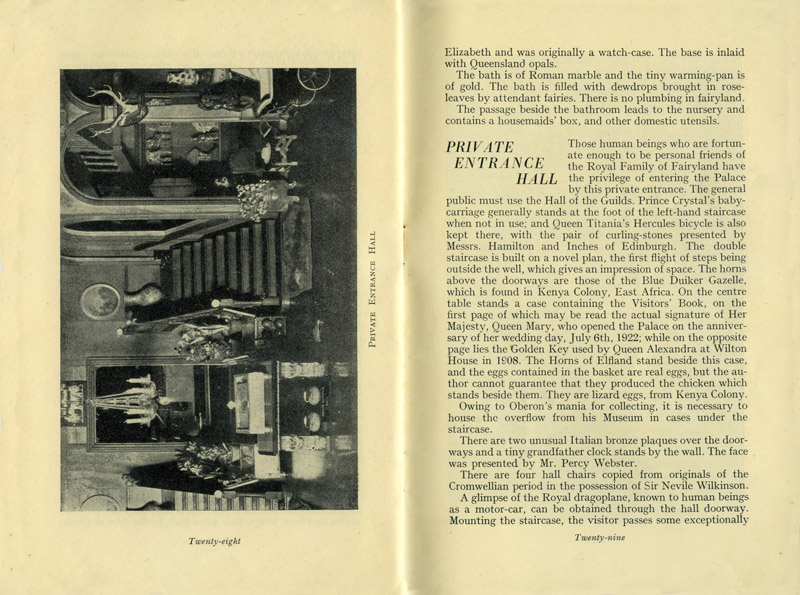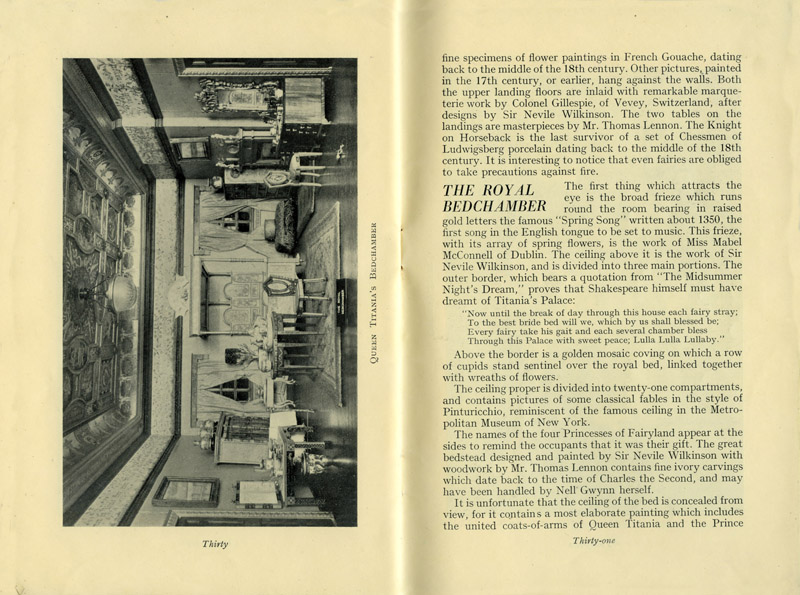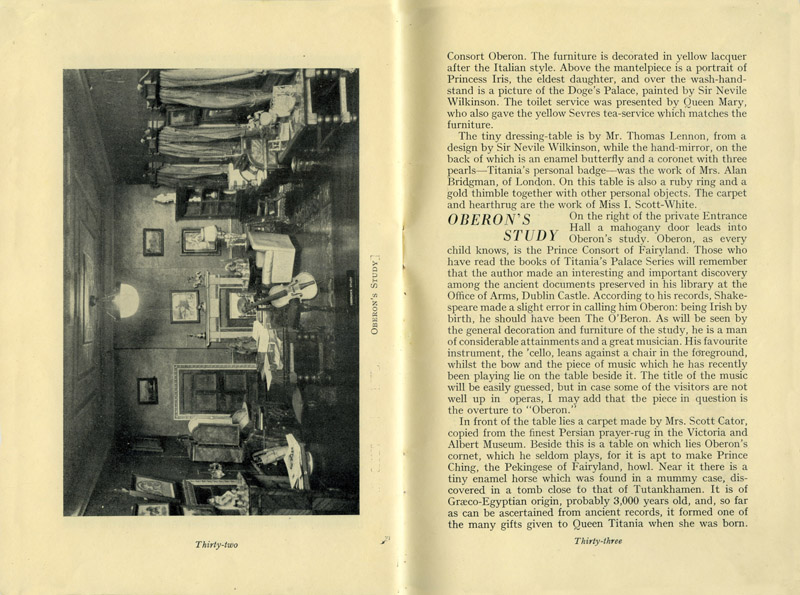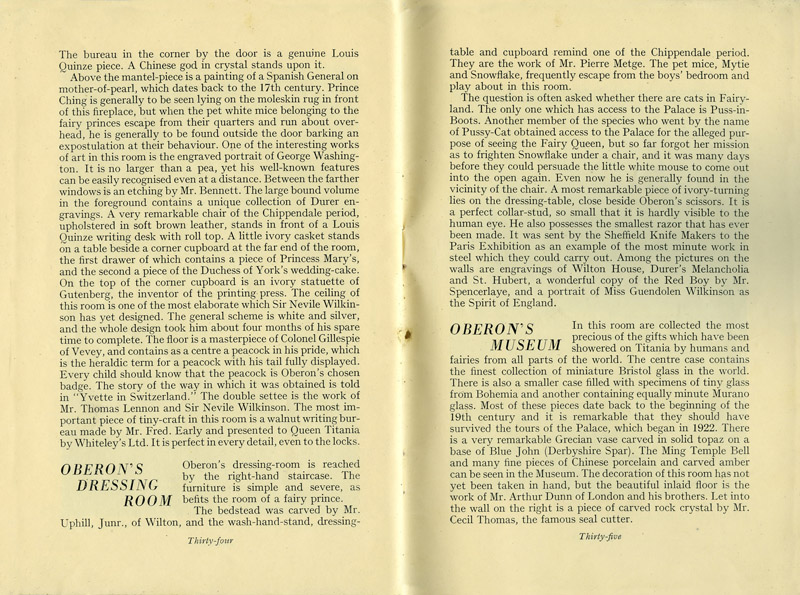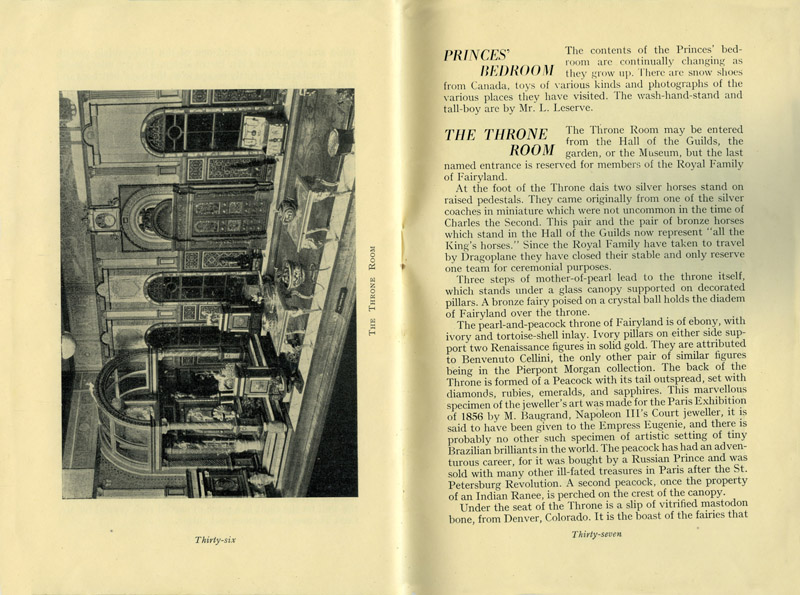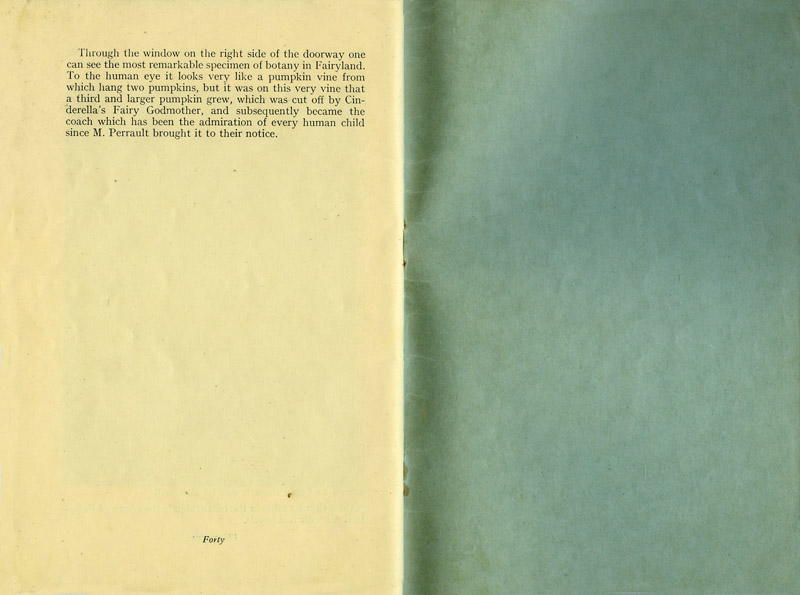A FAIRY PALACE IS BORN
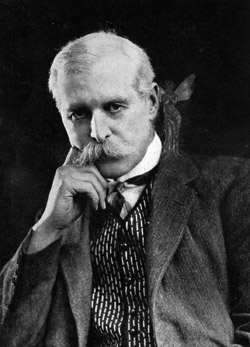
One hot summer's day in 1907, Sir Nevile sat at his easel, pencil in hand, in the woods behind the broad walk not far from the gates which once adorned Sir Matthew Decker's Villa at Richmond. Nearby stood an old sycamore tree and Sir Nevile was trying to represent as faithfully as possible the intricacies of bark which peeled from the old trunk, also each individual leaf of a young laurel which grew gracefully beside it. Guendolen, aged three, became very excited as she said she saw a fairy running under the roots of the sycamore. His daughter's vision of a fairy queen descending into the roots of a tree nearby was the first link in a chain of thought which led him to believe that there must be some hidden dwelling underground. Hence came the desire to build a fairy palace and so the foundation stone of Titania's Palace was laid. There was nothing new in building a dwelling house or palace as these had been built before as costly gifts to baby princesses and princes. Some are preserved in museums at Niirnberg, Delft, Haarlem and elsewhere. Famous dolls' houses are still to be seen in England with furniture made under the supervision of Chippendale.
Sir Nevile had already created a miniature mansion known as Pembroke Palace which was opened for exhibition by Queen Alexandra in 1908 in Wilton House. Pembroke Palace is a large dolls house six feet ten and a half inches long, four feet one inch high and two and a half feet deep on three floors. The main hall, dining room and the double cube room, although restored, are Sir Nevile's original work.
Three of his paintings, portraits of his father-in-law, the XIV Earl of Pembroke, of his daughter Guendolen and a self portrait hang in the double cube room. All the other paintings in the dolls house are miniature copies of paintings in Wilton House.
Titania's Palace was going to be something very different and also very special. Sir Nevile intended to build a home in which children could see the treasures of fairyland and broadcast to their friends all over the world that there were other children who were not as fortunate as themselves.
http://www.britishpathe.com/record.php?id=73239
http://www.britishpathe.com/record.php?id=28056
http://www.britishpathe.com/record.php?id=14649
http://www.britishpathe.com/record.php?id=16700
The building of Titania's Palace was commenced in 1907 by James Hicks in No. 5 Lower Pembroke Street, Dublin with detailed drawings by Sir Nevile. This would eventually be the home of Titania, "Queen of the Fairies," Oberon, her Consort, the Princesses Iris, Daphne and Pearl and Princes Noel and Zephyr. Some of the expert craftsmen to work for James Hicks were Fred Barley, Tommy Lennon, Pierre Metge, Charles Bennett, Horace Uphill and Arthur Dunn. In 1930 the father of the late Tommy Mitchell worked for James Hicks where all the repairs were carried out. T.J. Mitchell Ltd. are still operating as antique dealers in No. 4 Lower Pembroke Street, Dublin. The late Thomas Mitchell related before he died in 1992 that an old man arrived into his premises in Pembroke Street one day and examined a pair of Hicks tables. On his way out the old man said his name was Tommy Lennon. Thomas Mitchell remembered his father talking about this wonderful craftsman. Unfortunately, this was the last time he saw him. Thomas Mitchell's father was a full-time woodwork teacher in Ringsend Technical School for many years before setting up his business in Pembroke Street. Tommy was born in James Hick's house in No. 6 Lower Pembroke Street, Dublin. The family then moved to No. 13 Pembroke Street, then to No. 27 Pembroke Street. They bought the leasehold of No. 1A, then No. 1 and lastly No. 4 Pembroke Street where he died.
There is a painting in the National Gallery of James Hicks by Sean O'Sullivan. James Hicks died in 1934 leaving a reputation of having fashioned some of the finest furniture in the world and of course helping to build the eighth wonder of the world, Titania's Palace.
Just before Titania's Palace was complete, rumours of a great rival reached Sir Nevile. A royal dolls house designed by the premier architect in Britain, Sir Edwin Lutyens and 1,000 helpers was being constructed. It was to be filled with the work of every craftsman, painter and sculptor of note in the land. Even the tiny books which filled the library were to contain the actual writings of all the famous writers of the day. In short, all the kings horses were to be saddled and all the kings men mobilised to make this house not only a worthy gift to Her Majesty but worthy to be handed down for generations to come. The position for Sir Nevile was critical and the fate of twenty years work hung in the balance as Sir Nevile hoped to have one more year to complete the 101 details whose absence would be noticed when Titania's Palace faced the footlights.
The first of the eight sections to be finished was the marble lined Hall of the Guilds and shown at the Miniature Painters Exhibition. As a result of this an offer came to exhibit the whole palace in a prominent place in the Women's Exhibition held at Olympia, London under the auspices of the Daily Express, if it could be finished in a few months. All hands went to work with a will and were well rewarded, for in sixteen days, 17,000 visitors paid their respect to the fairy queen and the substantial sum of £420 was divided between the Children's Union of Waifs and Strays Society which cared for sick children and the League of Pity for the National Society for the Prevention of Cruelty to Children.
The Palace was built on a scale of 1" to 1 ft. in 100 year old mahogany. It was constructed in eight parts and set on a curtained pinewood stand and lit and heated by electricity. The stand was attached to a brass mounted pedestal and a protective rail which serves as a seat for young children. The palace is 116" long, 19" wide and the main bulk is 30" high. The dome and cupola over the chapel add another 65" to its height. The walls are ornamental in bronze, its windows fitted with stained glass. Sir Nevile, as mentioned earlier, had attended the Royal College of Art in South Kensington, London and had developed an interest in miniature decorative painting which involved a technique which he called "mosaic painting" using an etchers glass. He stippled minute dabs of watercolour all irregularly shaped like mosaic and numbering 1,000 or more per square inch. The result was ideally suited to the decoration of Titania's Palace. The inlaid floors are the work of a fellow officer artist Colonel Alexander Gillespie of Vevey, Switzerland. Sir Edwin Lutyens P.R.A. designed a belfry reminiscent of the Church of St. George, Hanover Square, London. The palace became more and more elaborate until it was finally opened by Queen Mary on her wedding anniversary on the 6th of July, 1922. Sir Nevile had at last fulfilled his dream of building Titania's Palace as an amusing method of raising money for children's charities and bringing good into a troubled world. As the palace expanded so did Sir Nevile's collection of miniature works of art. Some dated from the 16th century, some were contrived with imagination and others were made by distinguished craftsmen.
Sir Nevile showing the palace to a young
Princess Elizabeth and Margaret in 1920s and below
examples of the minute detail found in the palace
Sir Nevile intended the palace to travel all over the world and this necessitated the help of the expert packers Shorthalls of North Dublin. The eight sections were light enough to be easily moved and lowered into padded packing cases without danger and transported on a 4 tonne lorry. The packers travelled to 160 cities in the British Isles before going on to North and South America, New Zealand, Canada, The Netherlands, Australia and of course Dublin and Ballynastragh, Gorey, Co. Wexford.
 |
TITANIA'S PALACE GOES TO DENMARK
After many months of discussion the Trustees of Titania's Palace decided, with great sadness, that owing to the loss of its permanent home in Ireland after the death of my mother, that it was impossible to carry on exhibiting the Palace as in the past.
The Palace was therefore sold at Christie's in October 1967, and its new home - most beautifully prepared for it with great care - is at Wookey Hole where we hope that it will continue to give pleasure to all who visit it.
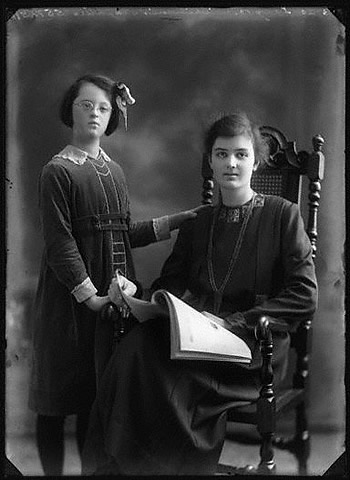
A portrait of sisters Guendolen and Phyllis Wilkinson
© The National Portrait Gallery, London.
Meanwhile, Guendolen and Phyllis had rented a house in Ballynastragh from Sir Anthony Esmonde who was a neighbour and exhibited the palace there. This was a Georgian house designed by Sir Edwin Lutyens. During these years, 287,702 people went to visit Titania's Palace and contributed £50,000 per year towards children's charities and this without any advertising whatsoever. In 1965, Titania's Palace was packed and lodged for safe-keeping in the Bank of Ireland. Guendolen went back to England with Phyllis to live in a house on the Pembroke Estate called East Knowyle in Wiltshire. The Trustees at this time were Guendolen, Lady Hamilton, herself a Pembroke and Mr. John Wylie of The Royal Dublin Society. This was known as "Tiny Crafts Ltd." . The RDS proposed building a special centre at a cost of £30,000 on the corner of Simmonscourt Road with its own entrance. Meanwhile the palace was taken to Harrods of London in connection with an Irish promotion, one of which was Erin Soups. On one occasion the lady who was ladling the soup to potential customers was putting on her upmarket demonstration accent when accidentally she spilled the soup.' Suddenly her real accent and character appeared as she let out a string of curses. Part of the Trustees' difficulty was that if the palace was not put on display for children's charities it must be sold by auction and the funds distributed accordingly.
In 1967 Titania's Palace went up for auction and was bought by a Director of a London dealer called Spinks at Christies. The price was £31,000. The Irish Rehabilitation Institute dropped out of the bidding at £30,000. Guendolen hoped that whoever purchased the palace would still place it on permanent exhibition as this was her father's wish. After the bidding there was confusion as the Irish representative said that they had also bid £31,000. The new owner was now a Mrs. Olive Hodgkinson who put it on display in Wookey Hole Caves, Somerset and later in Jersey where she went to live. When in Somerset it was visited by forty to sixty thousand people a year. It was exhibited at Fort Regent, St. Helier until November 1977. After Mrs. Olive Hodgkinson died her Trustees again put Titania's Palace up for auction at 12.00 noon on Tuesday, January 10, 1978. The bidding ended at £131,000 in favour of Legoland in Denmark. Before opening the palace for exhibition, three experts worked constantly on recording and restoring the miniature furniture and articles. Each single subject was photographed as it was not possible to record the articles otherwise. The palace was placed in a special exhibition hall and was opened in 1980. Sixty subjects have been put on display separately in small circular showcases allowing the visitors to view the tiny masterpieces. A twelve minute colour film in English, German and Danish is constantly running at the exhibition informing the visitors of the various rooms and the single subjects.
Enjoy listening to Lady Wicklow and her sister, interviewed by Gerard O' Kelly in 1989. Her reminiscences include a meeting with Sir Nevile, Titania's Palace, and much more....
A TOUR OF THE PALACE
The Hall of the Guilds
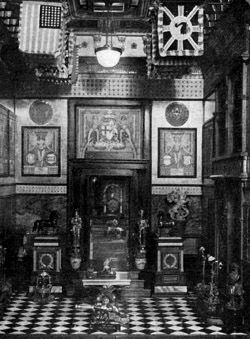
The Hall of the Guilds covers an area of twenty one by twenty feet and is twenty seven inches in height. The floor is laid with alternate slabs of black and white marble, one inch by one inch. The dado rail is of green Connemara marble. The first object of interest is a bronze gilt cannon, four and a half inches long. It is the work of Michael Mann of Nuremberg, Germany which is a perfect specimen made at the end of the 16th century. With the miniature working model, the commercial traveller of the day could demonstrate to the potential client exactly how the real cannon operated. There is also a tiny treasure chest with a complete lock in the lid. It is the work of a Nuremberg craftsman of the 15th century. There is also a Swiss gold mechanical oval fountain worked from a clockwork mechanism in the interior, set with small diamonds with a blue enamel background and a gold canopy two and a half inches high, from the late 18th century.
The Hall of the Fairy Kiss
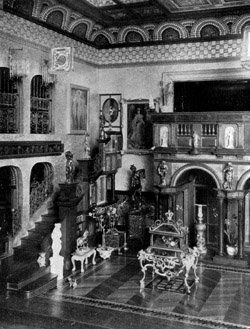
The furnishings in the Hall of the Fairy Kiss include miniature portraits of Queen Alexandra and Queen Mary painted by Sir Nevile Wilkinson. There are miniature gilt bronze figures of the Virgin Mary and St. John two and a half inches high, from the 17th century and a miniature gilt bronze figure of the multi-armed Vamantaka with his Satki standing on reclining figures on an oblong lotus base with a Connemara marble stand supported by four ivory elephants typical of the late 18th Century. It also contains a Louis Philippe Ormolu miniature table with cabriole legs surmounted by winged cherubs' masks with glass top. It supported a casket containing a miniature insignia of the grand cross of the Fairy Kiss surmounted by a crown, the table being four and a half inches wide. The Minstrel Gallery is a masterpiece of cabinet making by Mr. Thomas Lennon from Sir Nevile's design. One of the windows is in real pot metal stained glass made by a Mr. Child in a studio owned by a Ms. Purser of Dublin. The door leading into the chapel is framed in one of the most perfect pieces of handwrought silver that has been made since the time of Cellini, the work of a Mr. Joseph Barker.
The Chapel
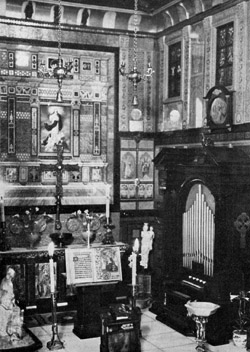
The chapel is Titania's private oratory and is the same size as the Hall of the Guilds, twenty one inches by twenty inches. The floor is laid in blocks of white Carrara marble, the lower panelling was executed by Mr. Thomas Lennon in mahogany, ebony, satinwood and Connemara marble. The design of the ceiling is adapted from the Book of Kells and painted by Sir Nevile. Above the altar is a wonderful reproduction in miniature of the Cross of Cong. There is also a miniature reproduction of the Ardagh Chalice with all the interlacing work and enamels faithfully represented. There is a perfect copy of James Watts' famous Chamber Organ in Glasgow with a bellows under the platform of which the keys can be played with a matchstick. This is thirteen and a half inches high. On a carved stand lies a French illuminated Book of Hours in white vellum made in 1450, also the smallest rosary beads in the world. Queen Titania gains access to her private oratory through a secret panel which leads into the boudoir.
Titania's Boudoir
The floor was laid by Colonel Gillespie from the design of the ceiling in the Ducal Palace at Mantua. The ceiling is inlaid in various woods by Thomas Lennon. The design is based on the ceiling of the Chapel Royal of St. James Palace by Hans Holbein. A real fire burns in the grate and the fender is made from an Irish napkin ring. There are two black lacquered chairs with seats of needleworked tapestry no bigger than a postage stamp which represents a peacock with tail outstretched. This is the work of a Ms. Morford. There is also a mirror above the fireplace carved by Pierre Metge of Skerries as well as the numerous chairs in the palace.
Princesses Iris and Ruby's Room
The furniture was decorated by Sir Nevile in the Bohemian style. There is a set of French china on the washstand. There is also a silver towel rack which carries the household linen, toothbrushes, soap and sponges. The room also contains four paintings which were a gift from Queen Mary.
The Dining Room
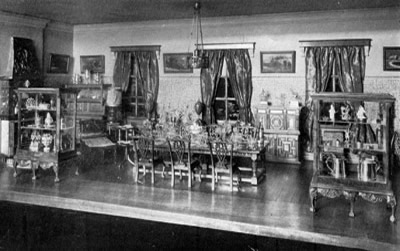
The dining room contains nine exquisite landscape paintings by Claes Molinaer which were executed in the middle of the 17th Century. The fireplace is made of Connemara Marble crowned by a bronze hood. The floor is inlaid with strips of satin walnut, the table is made of walnut veneer obtained from the case of a 200 year old clock. The chairs are Chippendale in style made by Pierre Metge with seats of Bargello worked by a Ms. Kathleen Kelsey. There is a remarkable sideboard in satinwood, a masterpiece by Fred Early. The table is laid with Bristol and Nailsea glass and English silver including five wine coasters and two Irish potato rings.
The Day Nursery
In this room there is a miniature gold model of a bicycle one and a half inches long with swept back handlebars and wheels set with sapphires. There is an ivory clock made by Colonel Gillespie, the friend of Sir Nevile. Also toys from all parts of the world from San Francisco to Calcutta. The day nursery fender is made of three solid gold slave bangles.
Princesses Daphne and Pearl's Room
One of the principal features in this room is the beautifully decorated cupboard in which their spare wings are kept. Fairies always have a clean pair of wings on Sundays and these are dyed in a rock crystal basin in the bathroom.
Sir Nevile decorated most of the furniture in this room. The toilet service is of limoges porcelain and the embroidery on the sheets and towels is the work of young girls who were in a hospital in Croydon, London.
The Morning Room
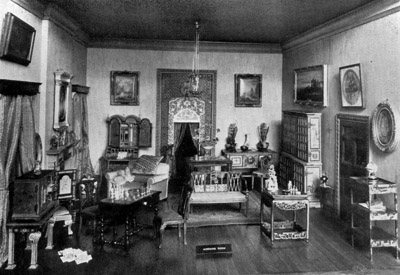
A bureau in the Queen Anne style stands in the Morning Room. Four of the tiny upper drawers could stand on a postage stamp. Each drawer is properly dovetailed and lined with cedarwood. This is the joint effort of Sir Nevile and Mr. Thomas Lennon. The bookcase was made by Harry Hicks and painted by Sir Nevile Wilkinson. It contains the most remarkable book collection in the world consisting of 75 volumes, bound in calf-leather including such titles as English, Scotch and Irish airs also Burns poems, first edition 1786, all in miniature. Also in the Morning Room is a watercolour by Samuel Palmer painted as a wedding present for Mrs. A.E. Wilkinson the mother of Sir Nevile. This painting is two and three quarter inches by six and a quarter inches.
The Bathroom
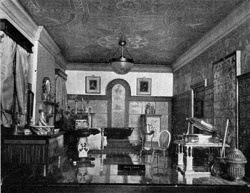
The ceiling of this room is the work of Sir Nevile and contains 250,000 dots of painted mosaic. The floor was exhibited at the Royal Academy in 1927. There is also a 19th Century Dutch miniature silver clothes press, two and three quarter inches high.
The Private Entrance Hall
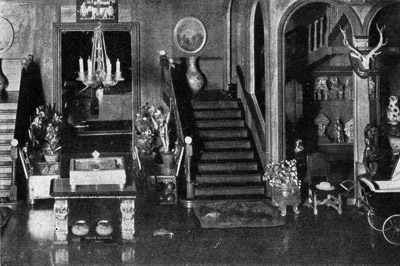
This is a large hall with two open staircases leading to the upper landings. In the hall is a rectangular showcase by a Percy Marks of Sydney on four lion feet inset with opal plaques and surmounted by the Royal Crown containing the visitors book with Queen Mary's signature on the first page together with signatures of Charlie Chaplin, Shirley Temple and W.B. Yeats. Hanging over the opposite page, when on display, is the golden key used by Queen Alexandra at Wilton House in 1908. The hall contains Queen Titania's Hercules bicycle six inches long, miniature bowls and curling stones.
The Royal Bed Chamber
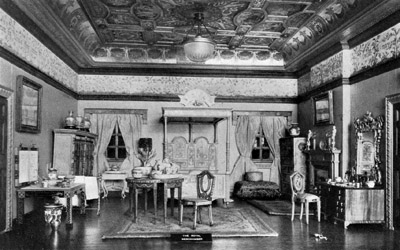
There is a broad frieze running around the room bearing the famous "Spring Song" in raised gold letters which was written about 1350. This was the first song in the English language to be set to music and was the work of a Miss Mable McConnell of Dublin. The ceiling is divided into 21 compartments reminiscent of the famous ceiling of the Metropolitan Museum of New York. The bedstead is by Mr. Thomas Lennon and contains fine ivory carvings dating back to Charles II. The toilet service was presented by Queen Mary who also gave the yellow tea-service which matched the furniture. In this room also, there is a 19th Century oblong shaped work table on cabriole legs with hoof feet, the hinged top pierced with foliage opening to reveal compartments two and a quarter inches wide. The dressing table is by Mr. Thomas Lennon from a design by Sir Nevile.
Oberon's Study

Oberon is the Prince Consort of Fairyland. According to the ancient documents preserved in the library at the Office of Arms, Dublin Castle, Shakespeare made a slight error in calling him Oberon. Being Irish by birth he should have been The O'Beron. His favourite instrument, the Cello, five inches high with the bow and a piece of music lean against the chair in this room. The title of the piece of music is "The Overture to Oberon." There is a carpet made by a Mrs. Scott Cator copied from the finest Persian prayer rug in the Victoria and Albert Museum. There is also a silver plated miniature teapot, coffee pot, milk jug, sugar bowl, slop bowl, cup and saucer, plate and toast rack on a circular tray. There is a miniature Chippendale armchair with arms and cabriole legs elaborately carved with shellwork and scrolls. The seat and back are covered in brown leather. There is also a walnut bureau case by Fred Early with broken arch pediment, the doors to the upper part containing drawers and pigeon holes. The sloping centre with fall front is similarly fitted with three long drawers below and an inlaid sun-ray medallion seven and a half inches high. Also in Oberon's study there is a tiny enamel horse which was found in a mummy case. This was discovered in a tomb close to Tutankhamen's and reckoned to be 3,000 years old. One of the interest-ing works of art in this room is the engraved portrait of George Washington, no larger than a pea, yet his well known features can be recognised from a distance. A miniature ivory casket stands on a table, the first drawer contains a piece of Princess Mary's and the second a piece of the then Duchess of York's wedding cake.
Oberon's Dressing Room
One of the most remarkable pieces of ivory turning lies on the dressing table. It is a perfect collar stud, so small it is hardly visible to the naked eye. Also here there is the smallest razor ever made. It was sent by the Sheffield Knifemakers to the Paris Exhibition as an example of the most minute work of steel that they could carry out.
Oberon's Museum
In this museum there is a case containing the finest collection of miniature Bristol glass in the world. There are two other cases containing Bohemian and Venetian glass dating from the beginning of the 19th Century. It is a credit to the packers Shorthalls that these delicate items should have survived the World Tours of the Palace.
The Prince's Bedroom
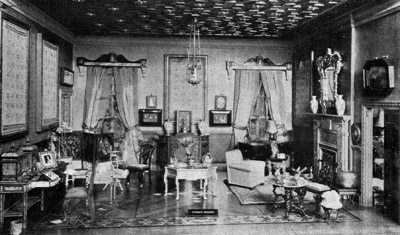
This bedroom contains toys of various kinds andsnow shoes from Canada.
The Throne Room
The Throne Room may be entered from the Hall of the Guilds, the garden or the museum. The bronze door which leads into a garden is a masterpiece by a Mr. Joseph Barker of Sheffield. There is also an ebony and ivory throne surmounted by two 16th Century miniature Italian gold figures of boys attributed to Benvenuto Cellini from the Heseltine Collection. These boys are seven eights of an inch high. There is a gem encrusted peacock standing on a pearl with its tail outspread and set with diamonds, rubies, emeralds and sapphires which was originally a brooch and was made for the Paris Exhibition of 1856 and said to have been given to the Empress Eugenie. It is two and a quarter inches high. The peacock had quite an adventurous career, for it was bought by a Russian Prince and was sold with many other ill-fated treasures in Paris after the St. Petersburg Revolution. A second peacock is perched on the crest of the canopy over the throne. This was once the property of an Indian Ranee. There is a frieze, four inches deep which runs around the walls.
The workmanship is so minute it took Sir Nevile one day to finish thee quarters of an inch. Also in the Throne Room there are reproductions of the horses which stand at the Palazzo Quirina in Rome. The height of the groom is two and three quarter inches. These were made by a French craftsman in the time of Napoleon I. Sir Nevile painted the mosaic type floor with 250,000 dots of watercolour and in the centre is a circular medallion inscribed in Greek which says "Silver and gold have I none but what I have I give thee." On one table in the room there is a solid gold bowl inlaid with uncut diamonds which came from the Royal Palace of Mandalay in 1866. Through the window is a beautiful view of the garden which is known as "Cupid's Court," also in the Throne Room there is a circular table with the "Crown of Fairyland" set with real jewels.
Extract taken from: Titania's Palace and The Mount Merrion Connection by Gerard O'Kelly
footnote:
When the Second World War broke out in 1939 Sir Nevile and his wife Lady Beatrix were living in London. Earlier on their house had been bombed so they both returned to live in the family house of the Earl of Wicklow, Shelton Abbey in Arklow. Sir Nevile died on the 22nd of December 1940 and was buried in Kilbride Churchyard, Arklow. On his death a meeting was held by the Irish Government of the day and the Office of Arms which had existed in Dublin Castle since 1552 was ended and the powers vested in the Irish Government. Most of his work is now carried out by the Genealogical Office in Kildare Street, Dublin. On the 5th of March, 1942 Lady Beatrix Wilkinson married the widower William Cecil, the Earl of Wicklow who lived at Shelton Abbey and was now titled Lady Wicklow. She died on the 3rd of December 1957 and was also buried in Kilbride Churchyard by the backgate of Shelton Abbey which is in the parish of Avoca and now an open prison.
Original booklet
twentieth edition - published 1925
